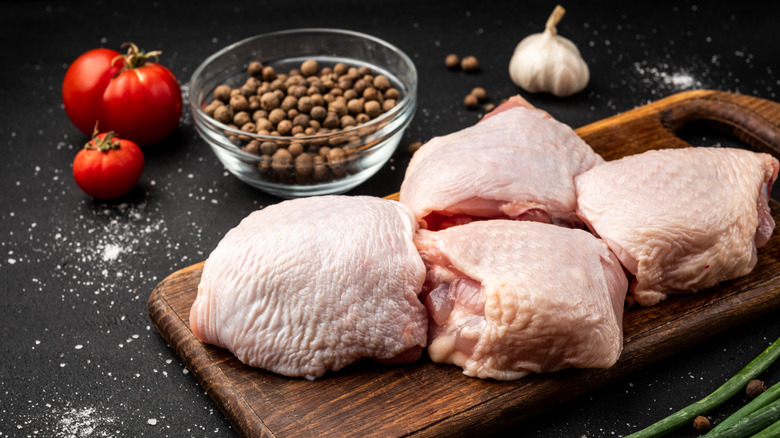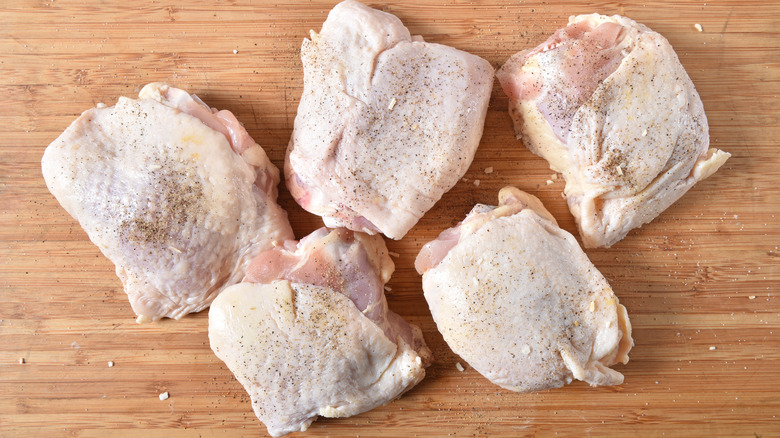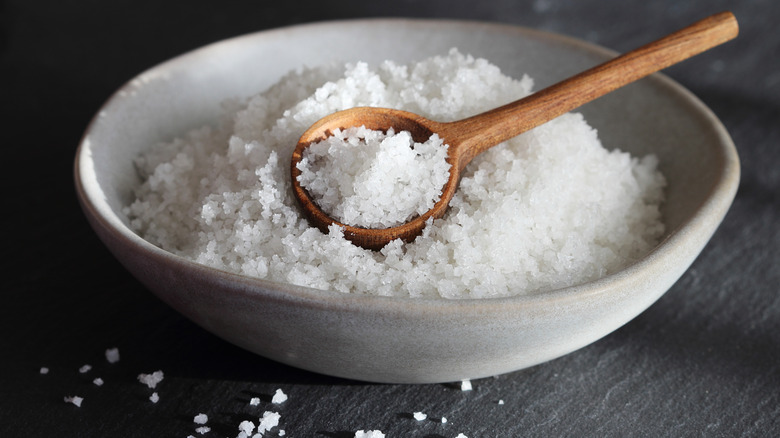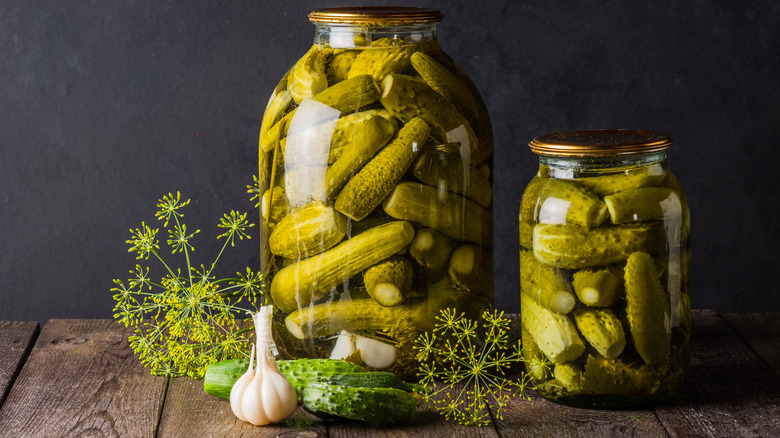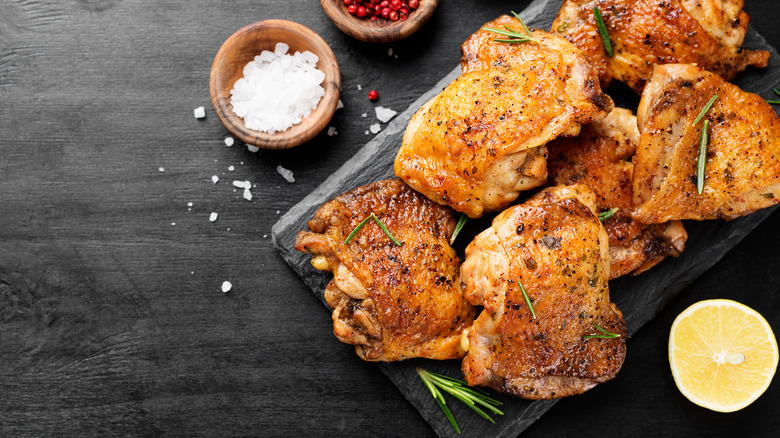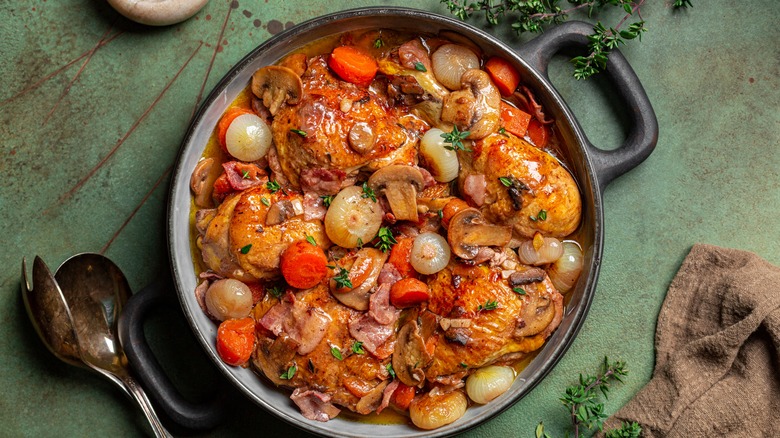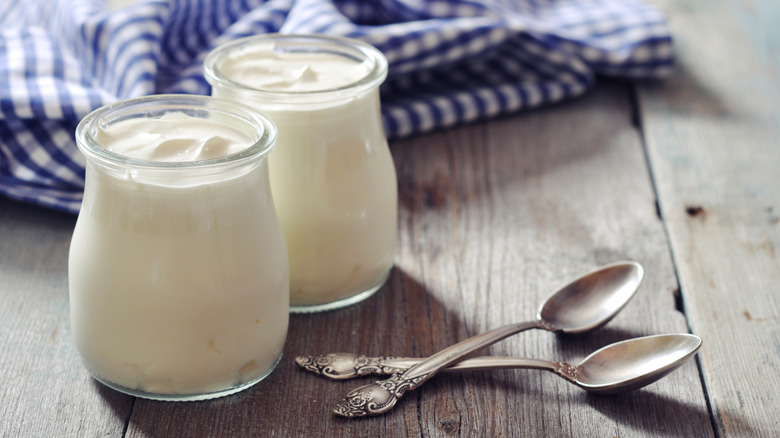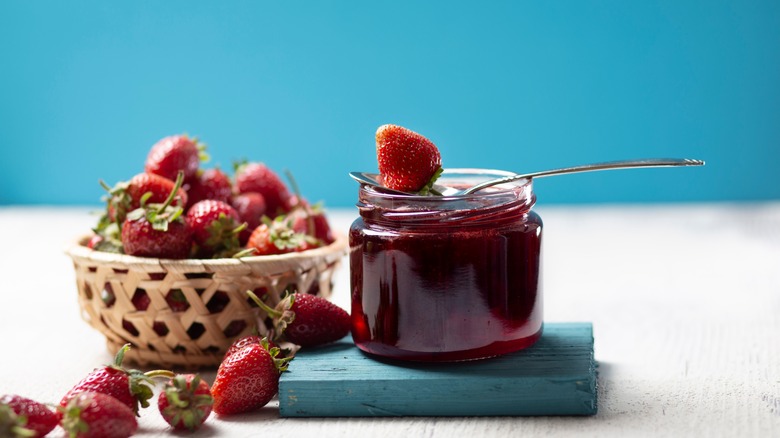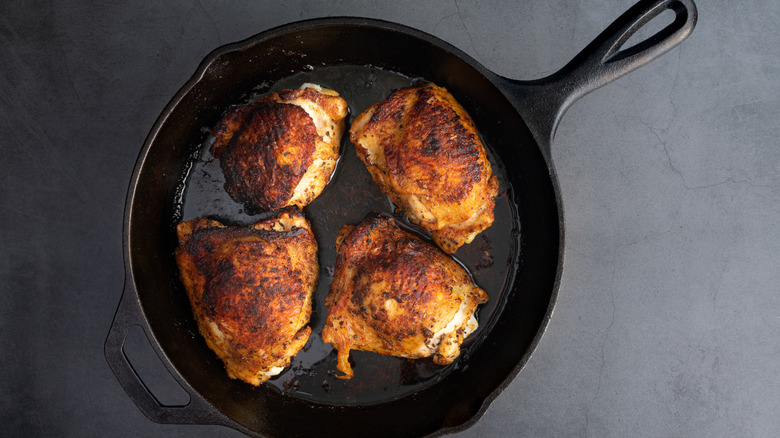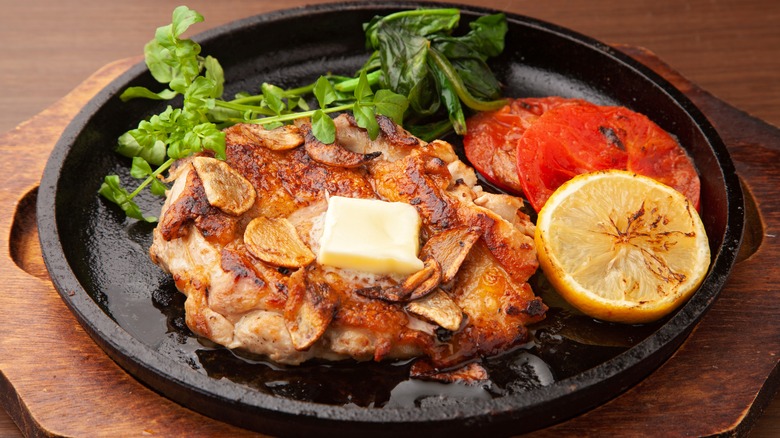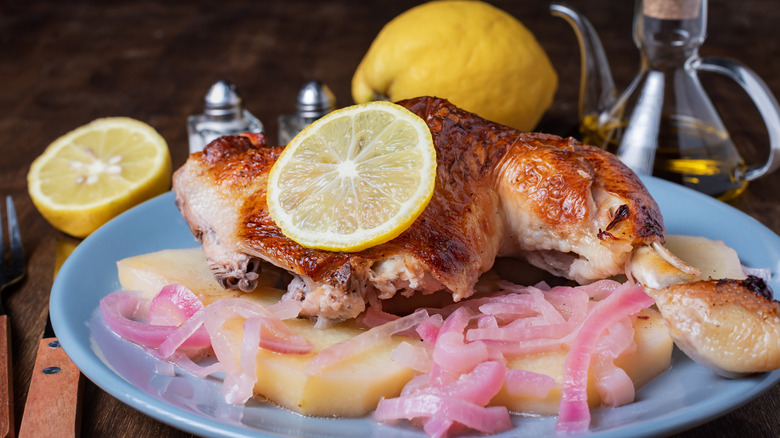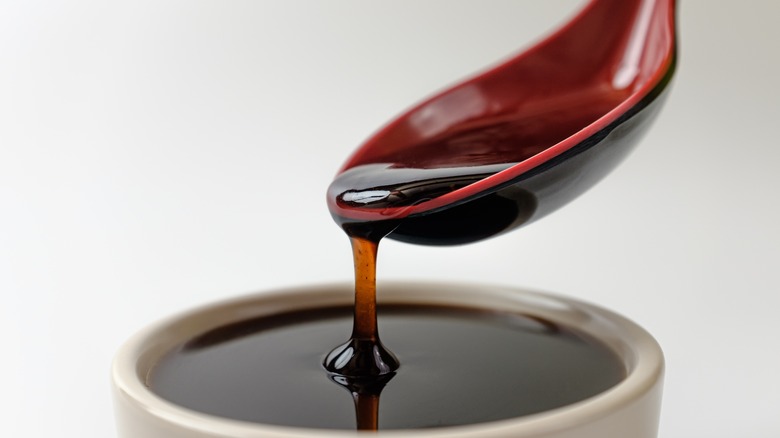12 Ways To Add More Flavor To Chicken Thighs
Chicken breasts seem to get all the glory when it comes to poultry. The ubiquitous ingredient is often touted as the staple for many clean-eating diets and lean-protein meal plans. But chicken breast can be finicky; it's easy to overcook and dry out, leaving you with a meal that underwhelms. So if the white meat is leaving your palate a little dry, maybe it's time to turn to the dark side and bring some thighs to the table. Chicken thighs are often less expensive than chicken breast and offer versatile meal options when you want to shake things up in the kitchen.
While dark meat tends to be more succulent than white meat, it doesn't hurt to have a few tricks up your sleeve to add more delish to the dish. Fortunately, chicken thighs are incredibly forgiving and easy to imitate with many different flavors. We've rounded up some of the best techniques for kicking those chicken thighs into high-flavor gear.
Buy thighs with the skin on
In our age of convenience, it seems like a no-brainer to buy your thighs with the skin already off. But you might want to rethink that. We, as consumers, have become used to buying skinless chicken, since skin harbors so much of the fat in the meat. However, fat is a flavor powerhouse, and you're paying more to have that flavor stripped away before your meal even hits the pan. Save yourself the money and always buy your chicken meat with the skin on.
Not only does the skin provide flavor, but it also locks in moisture while your chicken thighs are cooking. By keeping the skin on during the cooking process, you're creating a self-basting environment, allowing the melting fat to wash over the meat. Of course, you don't have to eat the skin once the meat is cooked, you can always discard it. Or you can get super crispy chicken skin by using a brick or weight to get the ultimate sear. Whichever way you go, keep that skin on while the chicken is in the pan!
Salt or brine thighs before cooking
Brining is one of the most important steps you might be skipping when it comes to your chicken preparation. There are two types of brining: wet and dry. Wet brining involves soaking the meat, typically overnight, in a salty liquid, while dry brining involves rubbing salt directly on the skin and meat of the chicken.
Water is the true enemy of flavor. To that end, when dry-brining, you want to make sure that you're removing as much excess water from your chicken thighs as possible before you cook them. This is extra important when you have the skin on the meat, especially if you plan on eating the meat. Dry raw skin means delicious, crispy cooked skin. Patting the skin and meat dry with a paper towel is the first step. The next step is to rub the meat and skin with salt and set the thighs in your fridge for at least an hour while you prep other components of your meal. The ensures moisture is drawn out of the skin, meaning you'll get the most satisfying crackling crunch on the outside when you cook it.
You could also make a tasty brine to infuse your chicken overnight. The hours-long salty soak will denature the protein in the meat, making it fall off-the-bone tender once it cooks.
Use a splash of spirits in your marinade
Much like brines, marinades are mixtures of spices and liquids that are often used to tenderize and add flavor to cuts of meat. You can help the marinating process by adding a splash of your favorite booze to your next chicken marinade recipe. Acid is a crucial part of a standard marinade recipe, and alcohol can be used in place of vinegar or lemon juice to act as a tenderizer. What type of liquor you use is really up to your personal taste, but wine and bourbon are popular marinade choices.
Of course, if you don't want the spirit-forward flavor, you can opt for using vodka, which will serve to tenderize while allowing the flavors of the other marinade ingredients to shine. Unlike brining, you typically don't need to allow the food to sit for too long in a marinade. A quick 15 to 30 minutes in your tasty spirit sauce will be enough for the flavor and the alcohol to penetrate the thighs and make them pan-ready.
Use leftover pickle juice for an easy marinade
You don't need to visit the bar to give your chicken an extra flavor shot in the marinade. Good chances are you have a super-star ingredient in your fridge already that has been just waiting for a chance to get in the game. You can use pickle juice as a one-step marinade for your chicken thighs. Pickle juice is, after all, a brine, loaded with spices, vinegar, and salt.
Pour the pickle juice into a Ziploc bag, add your chicken thighs, and let them sit in your fridge for two hours. This will let the marinade do its tenderizing magic. Even if you're not the world's biggest pickle fan, this trick is still one you should try. The pickle juice doesn't make your chicken taste like relish; the brine, instead, just gives it a pleasant tang and saltiness. You might never go back to other marinades again once you've discovered this easy flavor solution.
Give the thighs a poke before marinating
Whether you are using pickle juice, whiskey, salad dressing, or your own secret recipe, before you add your chicken thighs to your marinade, make sure that you give the raw meat a few jabs with a fork or knife. Piercing chicken is an important step during the marinating process because it allows the marinades to penetrate the meat.
Make sure that any punctures are made before adding the meat to the marinade and also well before you cook the meat. You do not want to poke holes into the chicken right before it hits the pan, that will cause the precious juices to run out of the meat and leave you with dry thighs. You also don't have to go full tattoo artist with your fork, just a few pokes will be all your chicken thighs need to soak up all the flavor.
Cook them low and slow
One of the greatest benefits of chicken thighs is that they are practically impossible to overcook. Unlike chicken breasts, which can dry out very easily and become rubbery, chicken thighs, because they are dark meat, get more tender the longer they are cooked. That's why chicken thighs are great for braised dishes.
Braising involves cooking food at lower temperatures for long stretches of time. This method of preparation is great for breaking down tough connective tissue and fat. As connective tissue breaks down, it becomes succulent gelatin, bursting with flavor and tenderness. You can cook chicken thighs in a 200 F degree oven for three hours for fall-off-the-bone meat, or, if you don't have that sort of time, you can compromise by raising the temperature to 325 F and cooking for half the time. Either way, braising chicken thighs is a classic method that yields amazing flavor.
Use dairy as a marinade
Yogurt isn't just a breakfast staple, it's actually an amazing ingredient for marinades. A lot of Indian and Middle Eastern cuisines use yogurt as the base for their marinades. The secret is lactic acid. Lactic acid works in the same way as vinegar, alcohol, or lemon juice. Through a chemical reaction, the lactic acid breaks down and tenderizes the protein in the meat. You can add herbs and spices to the yogurt while your chicken thighs marinate.
It's no secret that a buttermilk brine is an important component when you're making a traditional fried chicken recipe. The buttermilk serves the same role as the yogurt, providing a lactic acid bath for the meat to tenderize in before you cook it. You can even combine two of our tricks into one delicious dish by adding pickle brine to your buttermilk marinade, making a super-tasty soak for your chicken thighs.
Don't shy away from sweetness
While it might seem counterintuitive, adding a dose of sweetness to your savory dishes actually creates a nice rounding of the flavors. Fruits are often used as an ingredient that can bridge the flavor wheels of sweet and savory. Mixing a spoonful of strawberry or other fruit jam into your marinade or sauce can really make your dish pop.
Fruit plays nicely with the rich notes of balsamic vinegar in a pan sauce, or you could use a pastry brush to paint the skin of your chicken thighs before you bake them. The sugar in the jam will brown up and caramelize in the heat of the oven, adding a crackle to the cooked skin. Depending on what flavor profile you are looking for, you can explore using strawberry, cherry, fig, or grape jams as an addition to your marinades for the chicken thighs.
Keep the drippings
If you make chicken thighs often, you'll notice that they tend to release a lot of fat into the pan while they're cooking. While your first impulse might be to discard the drippings, don't be so hasty. Fat is what gives most food, especially chicken thighs, their flavor. There are lots of uses for the chicken fat that render out of those delicious thighs.
Once your chicken thighs have cooked, you can use the leftover fat to make a quick pan sauce. Toss in some wine or chicken stock and flour to the hot fat and cook it down to make a delicious sauce to pour over your chicken thighs. You can also cook your vegetable or potato sides in the fat to carry the chicken flavor throughout your whole meal. However you want to use it, make sure that you incorporate all that free flavor into your food.
Get saucy with it
Sauces are a fantastic way to add huge amounts of flavor. A quick pan sauce or an easy garlic butter sauce can really dress up a dish, taking it from plain to out of this world without a lot of extra effort.
Sauces tend to combine a mixture of fat, acid, and seasonings which tie together your dish. A lot of sauces can be made using ingredients you already have on hand, such as butter, garlic, and onions. Use the same pan that you cooked your chicken in to take advantage of the flavor left behind by the cooking process. Bone broth or stock will make your sauce silky and rich, complementing the dark meat of the chicken thighs.
You don't even have to flex your culinary muscles when it comes to sauces. A brush of bottled barbecue sauce onto chicken thighs before your bake them will give you a sweet, sticky, flavorful glaze that's sure to please.
Bring in brightness with citrus
It might seem like a simple addition, but sometimes the easiest solution is the best! Adding a drizzle of lemon juice to your baked or seared chicken thighs can add a huge burst of flavor to your finished dish. Fresh herbs such as thyme, sage, or rosemary, and lemon juice are often added to pan sauces to heighten the flavors. Citrus juice cuts through the richness of the fat and brightens the gaminess of the dark meat.
Another interesting way of adding lemony goodness to your chicken thighs is to brush lemon curd under and onto the skin of the thighs. Much like jams, lemon curd might not be the most intuitive addition to chicken thighs, but hear us out. The curd actually serves several purposes; the sugar in the curd aids in caramelization, the fat bastes the chicken in moisture, and the lemon brings that sunny citrus flavor.
Soy sauce imparts huge flavor
There are many varieties of soy sauce available on the market. Soy sauce is a pantry staple that a well-stocked kitchen should never be without. Whether you're whipping up a teriyaki sauce or you're just looking to add a dash of umami flavor, soy sauce is the answer to your culinary question.
When it comes to chicken thighs, soy sauce brings out the dark, earthy flavor of the dark meat. An easy glaze that you can brush onto your chicken thighs or use as a marinade contains just two ingredients: soy sauce and honey. Since soy sauce is such a versatile ingredient, you don't have to lock onto just an Asian palate. The salty richness lends itself to almost any cuisine. Don't shy away from adding soy sauce to your pan sauce or an existing marinade to bring out that umami flavor that chicken thighs embrace. You might not order take-out once you perfect your own chicken sauce!
